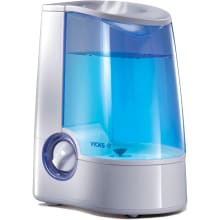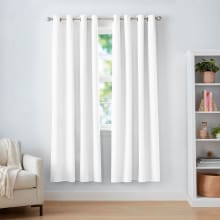I lived without heat for an entire winter—here are my tips for staying warm
No heat, no problem.
Products are chosen independently by our editors. Purchases made through our links may earn us a commission.
"Live in an old house that has character," they said. "It'll be fun," they said. But what they didn't say was that it would also be very (and I cannot emphasize that enough) cold.
That's because the house—which I moved into in the fall, when the temperature was perfect—lacked central heat. And I didn't realize exactly what no heat would feel like until it was negative 5 degrees in the middle of January and I was wearing a parka and gloves in my living room, trying to figure out how to stay warm without heat.
I found myself wondering just how to stay warm without heat?
Fortunately, I did. Because after a few days of whining to my mom and wallowing in my freezing cold self-pity, I decided to take action. Below are eight things that helped me (and my home) stay warm all winter long—no heat required.
Whether you’re experiencing power outages, trying to cut back on heating bills, or are simply blessed with a heatless home like I am, here are our tips for how to keep your house warm without heat.
How to stay warm with no heat
1. Choose your space heater wisely.

Tip: Always keep a 3-foot radius around your space heater to prevent fires.
No list of "stay warm" tips would be complete without mentioning space heaters. But not all of them are created equal—especially when it comes to heating power and safety features. Of all the space heaters we've tested, we like this one from Delonghi the best. It's quick to warm up a room and has an automatic shut-off function that makes it much safer than other models. One thing I learned? Space heaters are most effective when used in a small space and while they kept me nice and toasty sitting on the couch, they won't heat your entire home.

Keep yourself warm this winter with this compact space heater.
2. Reverse the ceiling fans.
Turning the ceiling fan on in the middle of winter seems counter-intuitive—but it isn't if you turn it on in reverse. That's because when the fan goes in the opposite direction, it actually pushes warm air back down into the room. (Wild, I know!) I was skeptical at first—and maybe this was a placebo effect—but it truly seemed to make a difference, especially in my bedroom at night.
3. Use a humidifier.
Did you know that the more moisture in a room, the warmer it feels? If not, now you do. I used a humidifier all winter long and while it didn't add heat, it did make the air less dry and more comfortable which made my house feel a lot cozier (and took care of my chapped lips from all that dry air too).
Our experts recommend the Vicks Warm Mist Humidifier because it's incredibly powerful and has enough capacity to run all night long (or for 10 hours straight!).

Prevent yourself from drying out with this humidifier from Vicks
4. Seal any cracks around your windows and doors.

This Duck Brand film is a must-have for drafty windows.
When you don't have heat, every single crack, hole, or crevice that lets cold air in makes a difference. Basically, caulk and home insulation kits are about to be your best friend.
I personally used this Duck Brand shrink film to insulate my windows (it's super easy to use) and this popular draft stopper—which has over 3,200 reviews on Amazon—to seal up the front door.
I recommend insulating even if you’re heating your home, as it will dramatically cut bills.

It may not look it, but shrink-wrapping your windows can help your home retain a lot of heat.
5. Open and close your curtains at the right time of the day.
What exactly is the right time, Amanda? So glad you asked. My advice is to keep your curtains and shades open during the day if it's sunny—all that natural light can warm up a room more than you might think. Then, as soon as the sun sets, shut the curtains. Bonus points if you have blackout shades like the Amazon Basics blackout curtains, or other great blackout curtains that provide extra insulation and trap warm air inside while keeping cold air out.

Regulate outdoor light better with some blackout curtains from Amazon.
6. Close off rooms that you aren't using.
Heat escapes into unused spaces. What's to be done?
This is a trick I learned from my very frugal mother. Don't waste your time—or your space heater's limited energy—warming up rooms that you don't spend a lot of time in, like a guest room or a formal dining room. A.k.a. keep the doors closed to those rooms to keep whatever warm air does exist in the rooms that you're actually using.
7. Cook in the oven as much as possible.
Your house might not have heat but your oven does. Turn it on to make dinner whenever you can and you can raise the inside temperature of your home at least a degree or two for a few hours. Plus the hot meals will help you feel warmer. Another hack I found to help? Leave the oven door open after you're finished using it to let all that hot air spread into the rest of the room (however, make sure the oven is off and do not do this if you have pets or kids who could get hurt!).
If you’re using an oven a lot, remember to make sure your carbon monoxide detector is working properly. If you don’t have one, pick up the Kidde Carbon Monoxide Detector.

Stay safe this winter with a carbon monoxide monitor.
8. Don't underestimate the power of layers.

The Comfy is exactly what you need to throw on top of your clothes.
It sounds obvious but layers are key to staying warm when your home is basically Siberia. That's because, unlike simply wearing a super heavy sweater, piling on multiple shirts or blankets traps body heat in between each layer. One of my favorite layering pieces? The Comfy, which is a blanket-sweatshirt combo that's hands-down the coziest thing I have ever owned. Combine it with a hot water bottle and luxuriate. I also recommend doubling up on socks along with slippers and wearing leggings underneath sweatpants.

Keep yourself cozy and warm with this wearable blanket.

